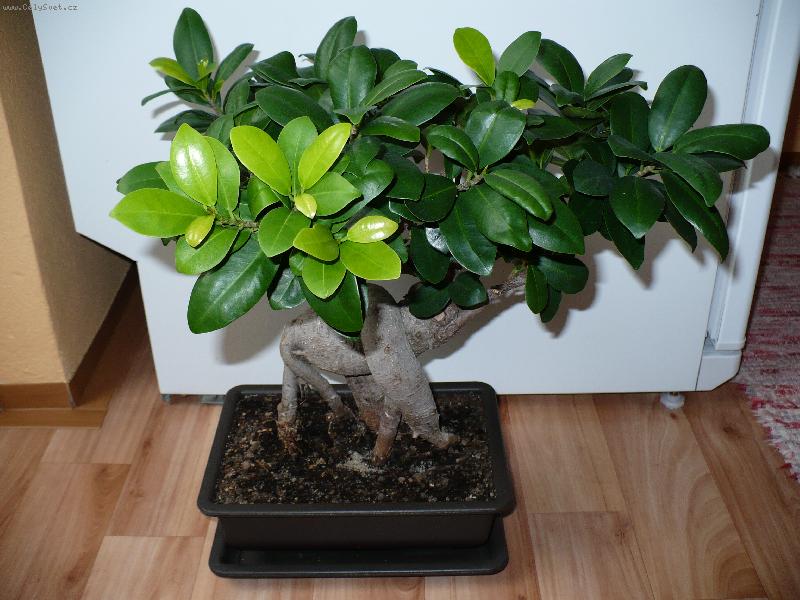
You have been dreaming of ficus for a long time, but not how do you decide to buy this beautiful flower? Our article will introduce you to the varieties of this plant, and also teach how to properly water it to feed and propagate.
The content of the article
- Ficus is considered a rather unpretentious plant that does not require special attention and care. Due to the fact that this plant develops well in almost any conditions, it is often used to decorate living space in apartments and to create a calmer atmosphere in large offices.
- Most often, in people's homes you can see ficus with rather large fleshy leaves of dark green color. But very often novice flower growers, having read about the unpretentiousness of this flower, are not quite correctly caring for it. As a result, instead of a dense crown, they literally have a couple of leaves of pale green color.
- Usually all this is due to the fact that the flower is improperly watered and forgot to wipe and moisturize its fox. If such a plant also appeared in your house, but you do not know what care it needs, then we suggest you get acquainted with the simple tips of experienced flower growers.
Varieties of ficus

Ficus Ali
In nature, there are more than 1450 varieties of ficus. But for landscaping apartments and the office no more than 20 is suitable. In the wild, ficus is more like a tree and can grow up to 25 meters high. It is clear that such plants are not suitable for residential premises.
If you allow you to live the area and height of the ceilings, then you can safely choose a tree -like plant in the form of a beautiful vine for yourself. But be sure to take into account the fact that for the development of such a flower there will be a lot of space. If he does not where to grow, then he will begin to change his color and drop the leaves.
Types of indoor ficuses:
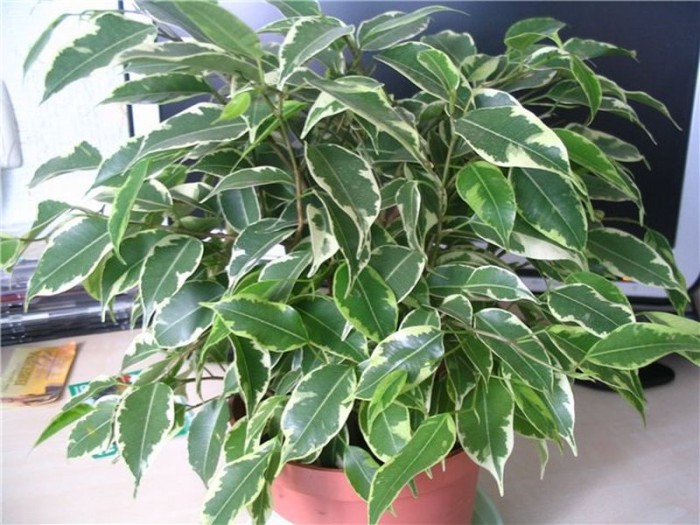
Ficus Benjamin
• Ficus Benjamin. This species has a rather flexible branches and a magnificent crown. The color of the leaves can be both dark green and light grass. Most often, ficus Benjamin is bought by Bonsai lovers.
They love this plant for the fact that it quite easily tolerates regular haircuts and quickly takes the desired shape. But remember, such a flower is very afraid of drafts and direct sunlight.
If you choose a not quite correct place for him, then the leaves will become quite thin and pale.
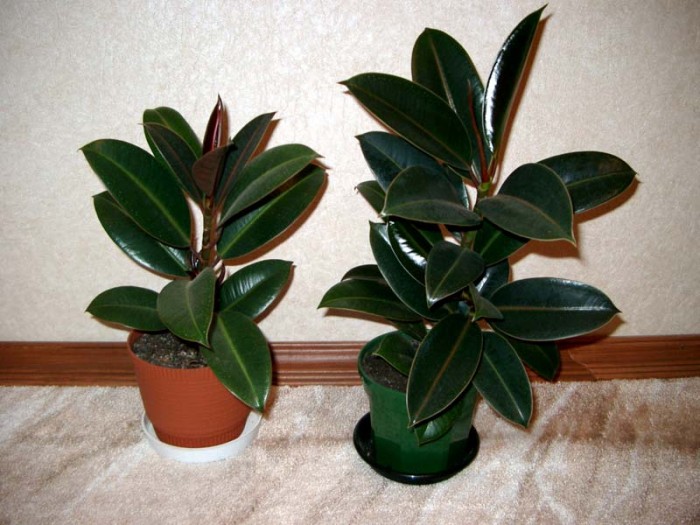
Ficus rubberous
• Ficus rubber. A young plant has one trunk and not a very developed crown. But with proper care (literally six months later), it begins to branch and form air roots on young branches. Over time, these roots also increase in size, reach the soil and new trunks begin to form from them. Most often, plants of this species have slightly pointed elliptical leaves. They can have a color, both dark green and red-brown.
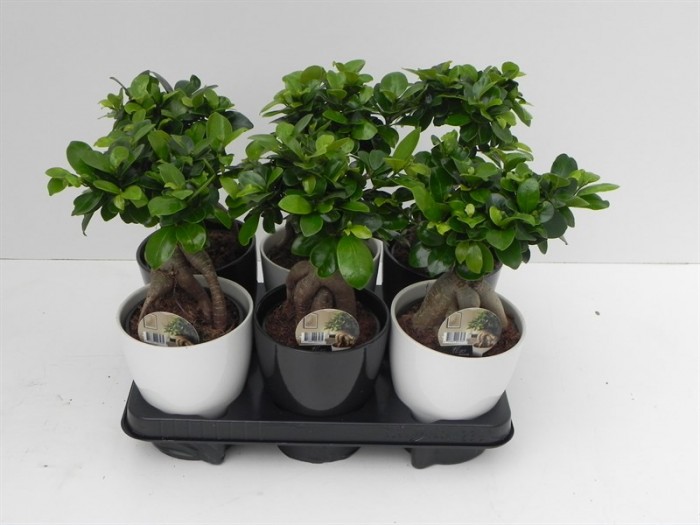
Ficus microcarp
• Ficus microcarp. This variety is somewhat similar to Ficus Benjamin. It has the same color, flexible branches and a tree trunk. But unlike Benjamin, the leaves of this ficus are slightly smaller and have a slightly rounded shape. It is necessary to place such a flower in a well -lit room, but at the same time it is necessary to avoid direct sunlight.
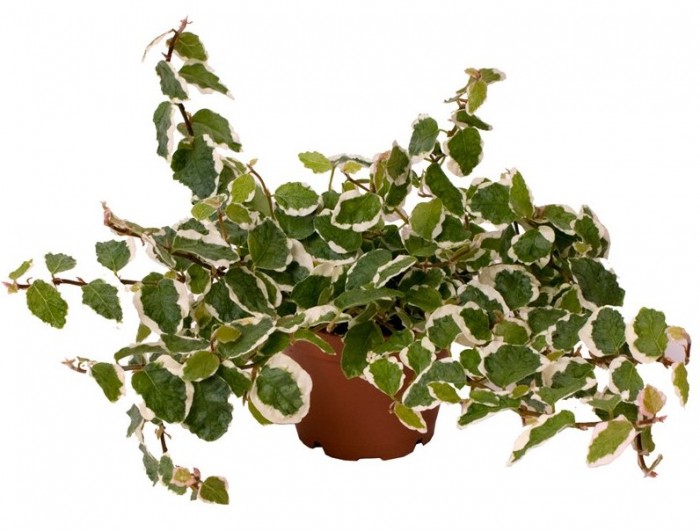
Dwarf ficus.
• dwarf ficus. A rather beautiful evergreen plant with rounded small leaves of dark green color. The flower has several stems decorated with a lush crown. Over time, air roots appear on it, which can cling to both the wall and special supports. He loves a moist environment very much, so it requires regular watering of the soil.
Home

Be sure to wipe the ficus leaves from dust
As you already, probably, understood for the home any of the above ficuses. Therefore, you only need to go to a specialized store and choose your favorite option. At home you will only have to find the right place for him and regularly care for him. How to do this correctly we will figure it out below.
So:
• Temperature regime. Ficus loves constancy, so it will be better if the same temperature will be constantly maintained in the room in which it stands. Ideally, the room should always be +15 ° C. But, of course, it is unrealistic to maintain such indicators at the same level for our latitude. Therefore, you allow that in winter the temperature drops to +12 ° C, and in the summer it rises to +18 ° C.
• top dressing. Ficus does not like fresh ground, so it is necessary to regularly introduce mineral and organic substances into it. In the spring-summer period, you need to do this every ten days. Moreover, it is necessary to alternate mineral and organic substances. With the onset of cold weather, it is necessary to gradually reduce the amount of top dressing and in winter to do this no more than 1 time per month.

Biogront for planting ficus
• Earth mixture. It is very important that ficus grew up in the right soil. In no case should it be planted in ordinary sandy soil. If you really want this plant to become a decoration of your house, then find for it turf or deciduous land and fuel it with sand, bone flour and overdue manure. Ideally, you should get slightly acidic soil, which does not exceed 6-7.
• Cutting. Ficus is required to carry out regular pruning. Moreover, this must be done not only for the formations of the form you need. If you notice that the plant has half -naked stems, then try to wake them. To do this, pinch the upper young shoots with special scissors (usually it is much lighter than the old ones). If you do this on time, then after some time the leaves will begin to appear on the bare stem. Such a manipulation should be carried out as a minimum 2 times a year.
Reproduction of ficus
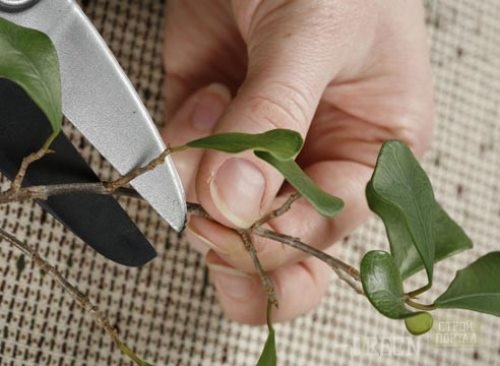
The ficus propagates in the blueberries
The most favorable period for the propagation of ficus is spring and first half of summer. Therefore, if you want you to succeed the first time, then without putting it in a long box, proceed to reproduction. Although it is considered this can be done exclusively with a cuttings, some professional flower growers do this with the help of leaves.
To do this, you need to take a sheet (it must be cut off with a heel), twist it with a tube and tie it to a stick for stability. The workpiece is stuck into peat, covered with a cap and periodically watered, sprayed and ventilated. After the leaflet is well rooted, it can be transplanted into a flower pot. Say right away, this method requires quite a lot of effort, so it is better to propagate ficus with cuttings.
So:
• Find a strong well -developed stalk and carefully cut it
• Manipulate with a sharp knife or garden secateur
• cut a twig (it should be at least 12 cm) put in clean water for two hours
• drain muddy water and replace it with fresh
• If there are leaves from below on the cuttings carefully remove them
• Change water as it is cloudy
• About two weeks after two weeks can be transplanted into a flower pot
• After planting, the ficus should regularly arrange a cold shower or at least wipe it with a damp sponge
How to transplant ficus correctly?
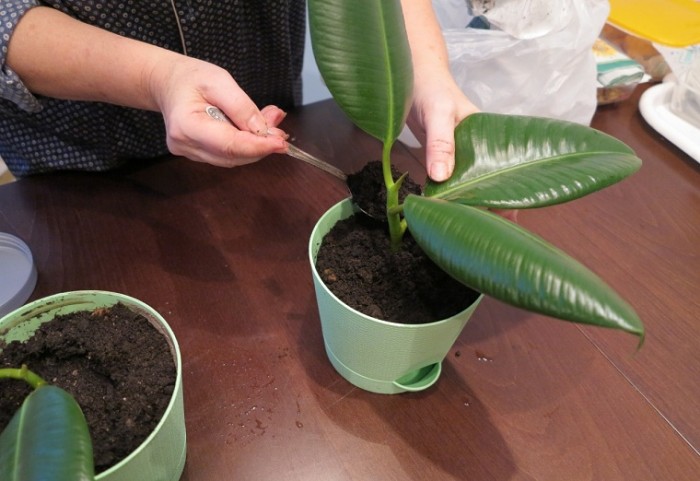
Ficus transplant
In order for Ficus to delight you with your thick and green crown, you must be able to correctly, and most importantly, transplant it on time. If you bought a young flower, then until four years of age it must be transplanted every year. Further, the ficus is transplanted no more than once every two years. The optimal time for this is spring and summer. It is proved that during this period the plant is adapted faster in a new space.
When transplanting, it is also necessary to take into account the size of the pot. It should be 3-4 cm larger than the previous one. If you transplant ficus into a very large pot, then it is likely to slow down a little. If for any reason you do not have the opportunity to transplant the plant, then be sure to replace the top layer of the soil.
Ficus transplant rules:
• Pour the plant abundantly and wait until the liquid is absorbed
• with a special spatula or spoon, remove the upper layer
• Put a drainage layer in a new flower pot
• Having shook a little, pull out the ficus from the soil and carefully jam the soil from the roots
• Put it in the center of the pot and evenly fill up with the prepared soil
• Press the ground slightly with your hands and pour the flower
How to water ficus?
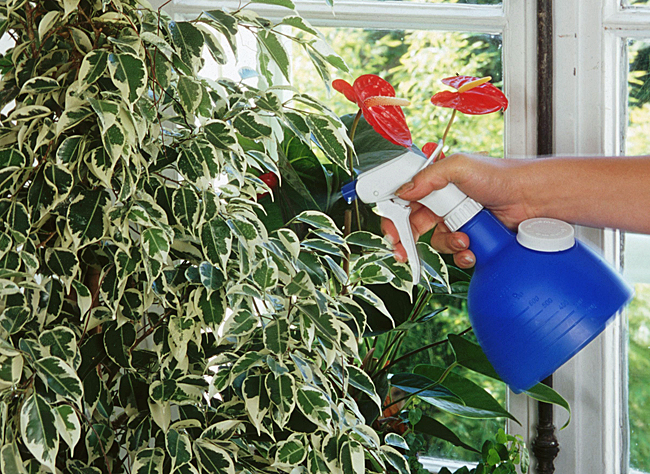
Ficus should be watered approximately once a week
- And in winter and summer, ficus requires exclusively moderate watering. In no case should not be poured or not water. This can lead to the fact that the flower will stop growing or, in general, die. An excess of moisture is especially terrible for him. If the soil is moist all the time, then the roots of the flower will quickly begin to rot. Therefore, in this case, you must adhere to the golden mean.
- Water ficus only when you see that the upper soil layer in the pot is completely dry. Typically, plants of this species are watered once every 5-7 days. But this does not mean that you should also adhere to such a temporary framework. If the upper soil layer dries very quickly, then watering can be carried out every 3-4 days.
- In addition, it is necessary to moisturize the leaves of the plant. This must be done 1-2 times a month. You can arrange a cool soul to him or just wipe the ficus with a damp sponge. In addition to additional hydration, this procedure will help you wash off the pests from a flower. After the shower, leave the plant in the bathroom for an hour and a half. After the excess fluid runs and the leaves dry out, you can safely return the ficus to its rightful place.
Why does Ficus drop the leaves?
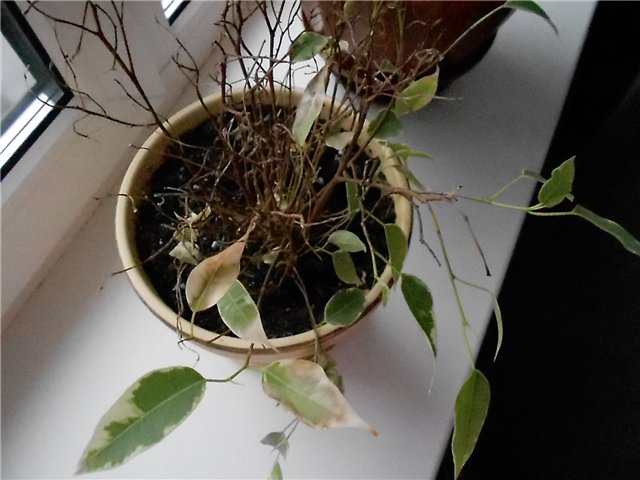
Ficus threw the leaves due to improper watering
Most often, ficus leaves turn yellow and fall off in the fall. In this way, the plant is prepared for winter. Therefore, if your flower has just disappeared a couple of leaves, then it is not worth it. But if for a long time the crown of the ficus is thinning, then what is wrong with it. In this case, you need to look for what he does not like and try to get rid of this problem.
The main reasons for dropping leaves:
• Very dry air indoors
• drafts
• Temperature fluctuations
• Bad light
• improper watering
• Soil is poisoned by pesticides
• lack of beneficial substances
Ficus leaves: fungal, parasitic
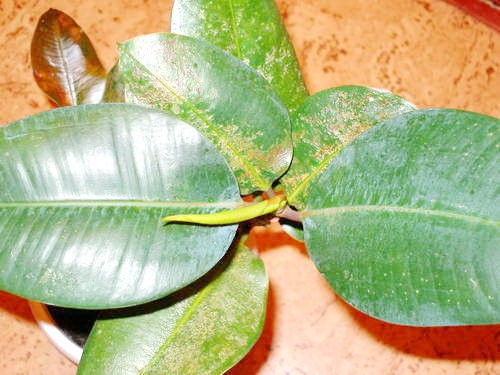
Fungal disease on ficus
No matter how well you take care of the ficus of one hundred percent probability that he will never get sick no one will give you. After all, it will become infected with any muck it may well from other plants. It can also happen when transplanting to other soil or open ground. After a transplant, be very attentive to your flower and, with the slightest signs of the disease, take measures to eliminate it.
Types of ficus diseases:
• fungal. In this case, the leaves are covered with powdery mildew, gray raid, mold and rusty spots. Fungal diseases can also affect the roots of the plant. If this happens, then ficus will not be able to save.
• parasitic. This type of disease involves the presence on the leaves, stems and roots of various bugs and worms. If your plant was struck by a parasitic disease, then there will be convexities of dark brown color, gray-brown spots and nodular growths. Special means can help these manifestations.
Pests of ficus

The defeat of the ficus with a shield
If it so happened that your plant was infected with pests, then first of all you need to urgently isolate it from the rest of the flowers. If you can try to fight them with folk methods a little more bugs. You can spray the plant with a decoction of chamomile, wormwood or calendula.
If after 36 hours you do not notice any changes, then process the ficus with specialized tools. They must be selected depending on which pest settled on your plant.
Types of pests:
- • Shield. Settles on the inside of the leaves and begins to suck the juice. Most often, this parasite provokes the development of the fungus.
- • Web tick. Usually this little bug appears if the room is very dry air. He bites into the leaves and branches thereby stopping their growth.
- • Trips. They like to be located along the veins of the leaves and drink juice from them. Most often, this leads to untimely falling leaves.
- • Pilvious wormer. Outwardly, this pest resembles a piece of cotton wool. You can find it in the axils of leaves.
